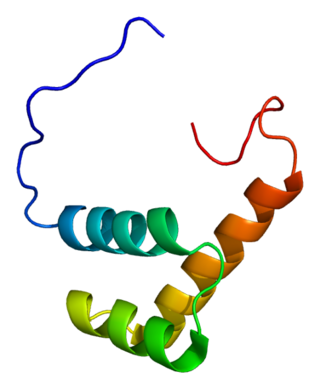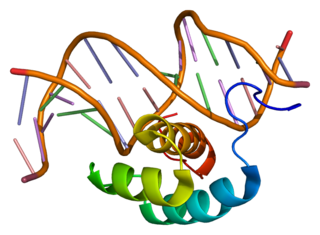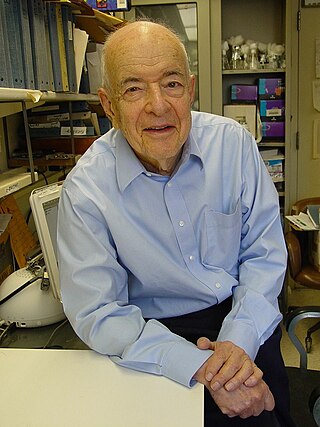
A homeobox is a DNA sequence, around 180 base pairs long, that regulates large-scale anatomical features in the early stages of embryonic development. Mutations in a homeobox may change large-scale anatomical features of the full-grown organism.

Haptoglobin is the protein that in humans is encoded by the HP gene. In blood plasma, haptoglobin binds with high affinity to free hemoglobin released from erythrocytes, and thereby inhibits its deleterious oxidative activity. Compared to Hp, hemopexin binds to free heme. The haptoglobin-hemoglobin complex will then be removed by the reticuloendothelial system.
Hox genes, a subset of homeobox genes, are a group of related genes that specify regions of the body plan of an embryo along the head-tail axis of animals. Hox proteins encode and specify the characteristics of 'position', ensuring that the correct structures form in the correct places of the body. For example, Hox genes in insects specify which appendages form on a segment, and Hox genes in vertebrates specify the types and shape of vertebrae that will form. In segmented animals, Hox proteins thus confer segmental or positional identity, but do not form the actual segments themselves.

Zinc finger E-box-binding homeobox 2 is a protein that in humans is encoded by the ZEB2 gene. The ZEB2 protein is a transcription factor that plays a role in the transforming growth factor β (TGFβ) signaling pathways that are essential during early fetal development.

HNF1 homeobox A, also known as HNF1A, is a human gene on chromosome 12. It is ubiquitously expressed in many tissues and cell types. The protein encoded by this gene is a transcription factor that is highly expressed in the liver and is involved in the regulation of the expression of several liver-specific genes. Mutations in the HNF1A gene have been known to cause diabetes. The HNF1A gene also contains a SNP associated with increased risk of coronary artery disease.

Homeobox protein MSX-1, is a protein that in humans is encoded by the MSX1 gene. MSX1 transcripts are not only found in thyrotrope-derived TSH cells, but also in the TtT97 thyrotropic tumor, which is a well differentiated hyperplastic tissue that produces both TSHß- and a-subunits and is responsive to thyroid hormone. MSX1 is also expressed in highly differentiated pituitary cells which until recently was thought to be expressed exclusively during embryogenesis. There is a highly conserved structural organization of the members of the MSX family of genes and their abundant expression at sites of inductive cell–cell interactions in the embryo suggest that they have a pivotal role during early development.

Homeobox protein Hox-B7 is a protein that in humans is encoded by the HOXB7 gene.
POU is a family of eukaryotic transcription factors that have well-conserved homeodomains. The Pou domain is a bipartite DNA binding domain found in these proteins.

Homeobox protein MSX-2 is a protein that in humans is encoded by the MSX2 gene.

Homeobox protein Hox-B6 is a protein that in humans is encoded by the HOXB6 gene.

Homeobox D10, also known as HOXD10, is a protein which in humans is encoded by the HOXD10 gene.

Homeobox protein Hox-B5 is a protein that in humans is encoded by the HOXB5 gene.

Homeobox protein Hox-B3 is a protein that in humans is encoded by the HOXB3 gene.

Carbohydrate-responsive element-binding protein (ChREBP) also known as MLX-interacting protein-like (MLXIPL) is a protein that in humans is encoded by the MLXIPL gene. The protein name derives from the protein's interaction with carbohydrate response element sequences of DNA.

Ras-responsive element-binding protein 1 is a protein that in humans is encoded by the RREB1 gene.

Homeobox protein NOBOX, also known as newborn ovary homeobox protein, is a protein that in humans is encoded by the NOBOX gene. The official symbol (NOBOX) and the official full name are maintained by the HGNC. The NOBOX gene is conserved in chimpanzee, Rhesus monkey, cow, mouse, and rat. There are 175 organisms that have orthologs with human gene NOBOX. It is capable of regulating other genes that are important in the development of follicles. Follicles do not develop and oocytes decrease in its absence which lead to infertility.
CUX1 is an animal gene. The name stands for Cut like homeobox 1. The term "cut" derives from the "cut wing" phenotype observed in a mutant of Drosophila melanogaster. In mammals, a CCAAT-displacement activity was originally described in DNA binding assays. The human gene was identified following purification of the CCAAT-displacement protein (CDP) and has been successively been called CDP, Cut-like 1 (CUTL1), CDP/Cut and finally, CUX1.. Cut homeobox genes are present in all metazoans. In mammals, CUX1 is expressed ubiquitously in all tissues. A second gene, called CUX2, is expressed primarily in neuronal cells.

Carole Ann Bewley is an American chemist. She is a senior investigator and Chief of the Laboratory of Bioorganic Chemistry at the National Institute of Diabetes and Digestive and Kidney Diseases. Bewley researches secondary metabolites and basic principles involved in protein-carbohydrate interactions and how these can be exploited to engineer therapeutics.

Herbert Tabor was an American biochemist and physician-scientist who specialized in the function of polyamines and their role in human health and disease. Tabor was a principal investigator at the National Institute of Diabetes and Digestive and Kidney Diseases where he was Chief of the Laboratory of Biochemical Pharmacology. He was the editor-in-chief of the Journal of Biological Chemistry from 1971 to 2010.

PBX/Knotted 1 Homeobox 2 (PKNOX2) protein belongs to the three amino acid loop extension (TALE) class of homeodomain proteins, and is encoded by PKNOX2 gene in humans. The protein regulates the transcription of other genes and affects anatomical development.
















